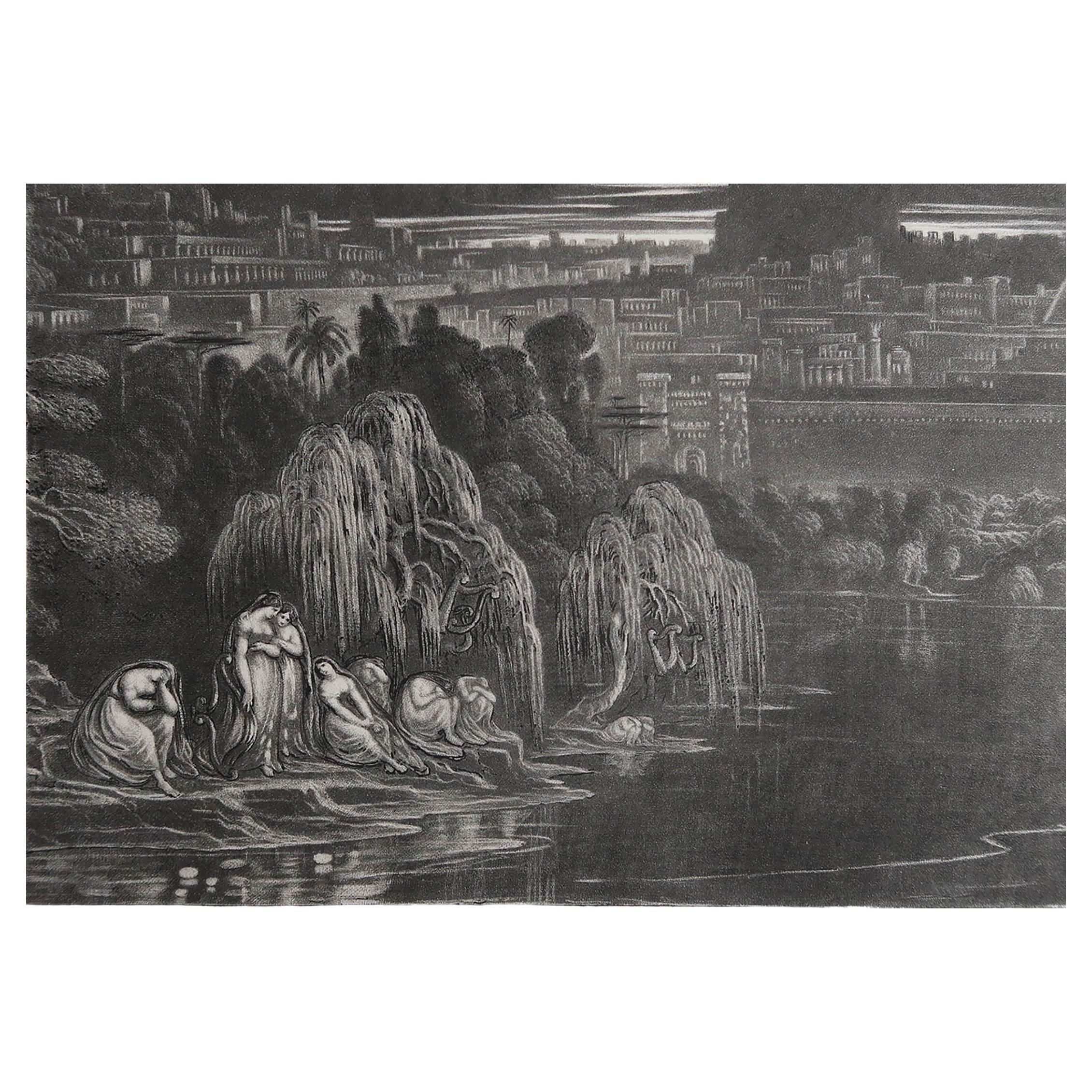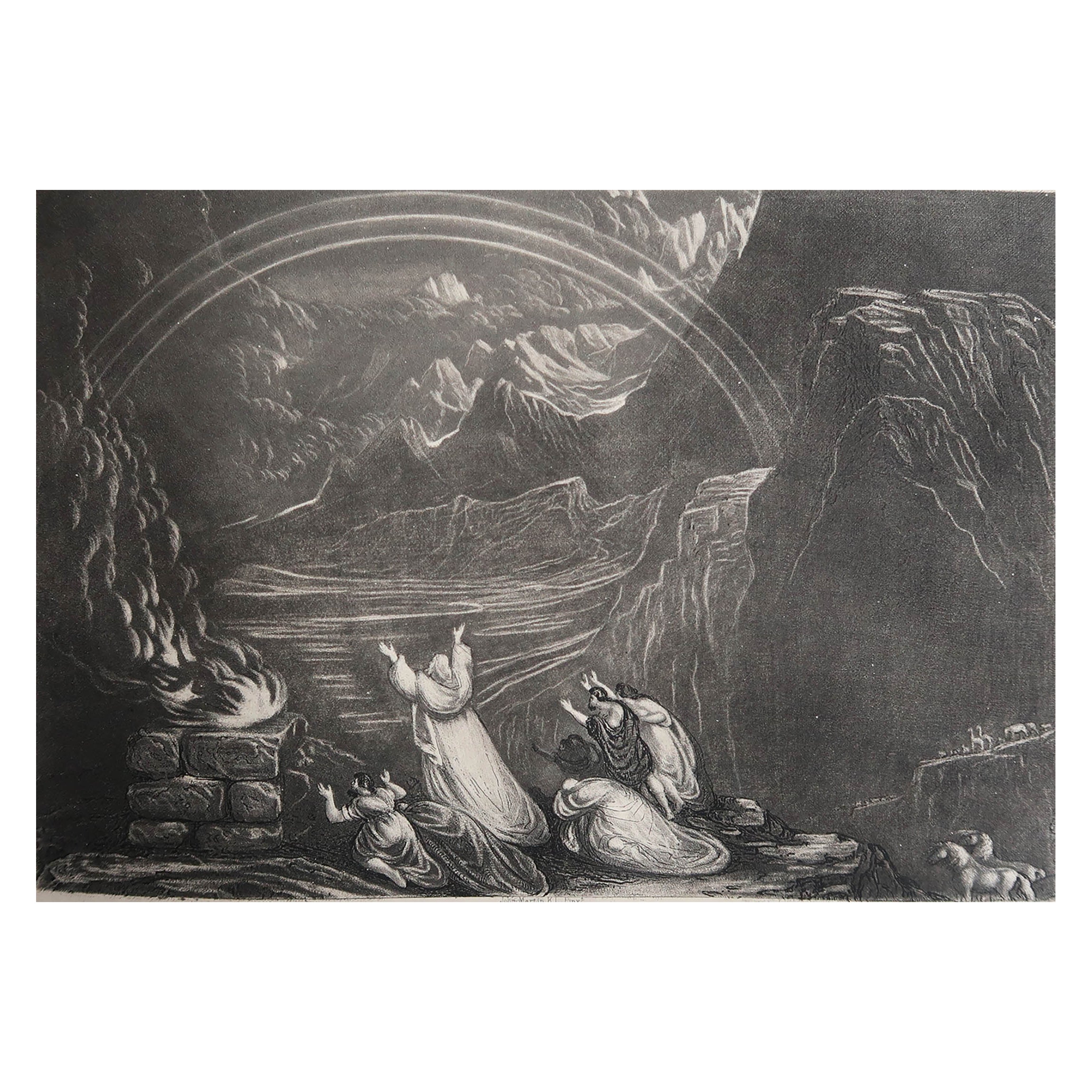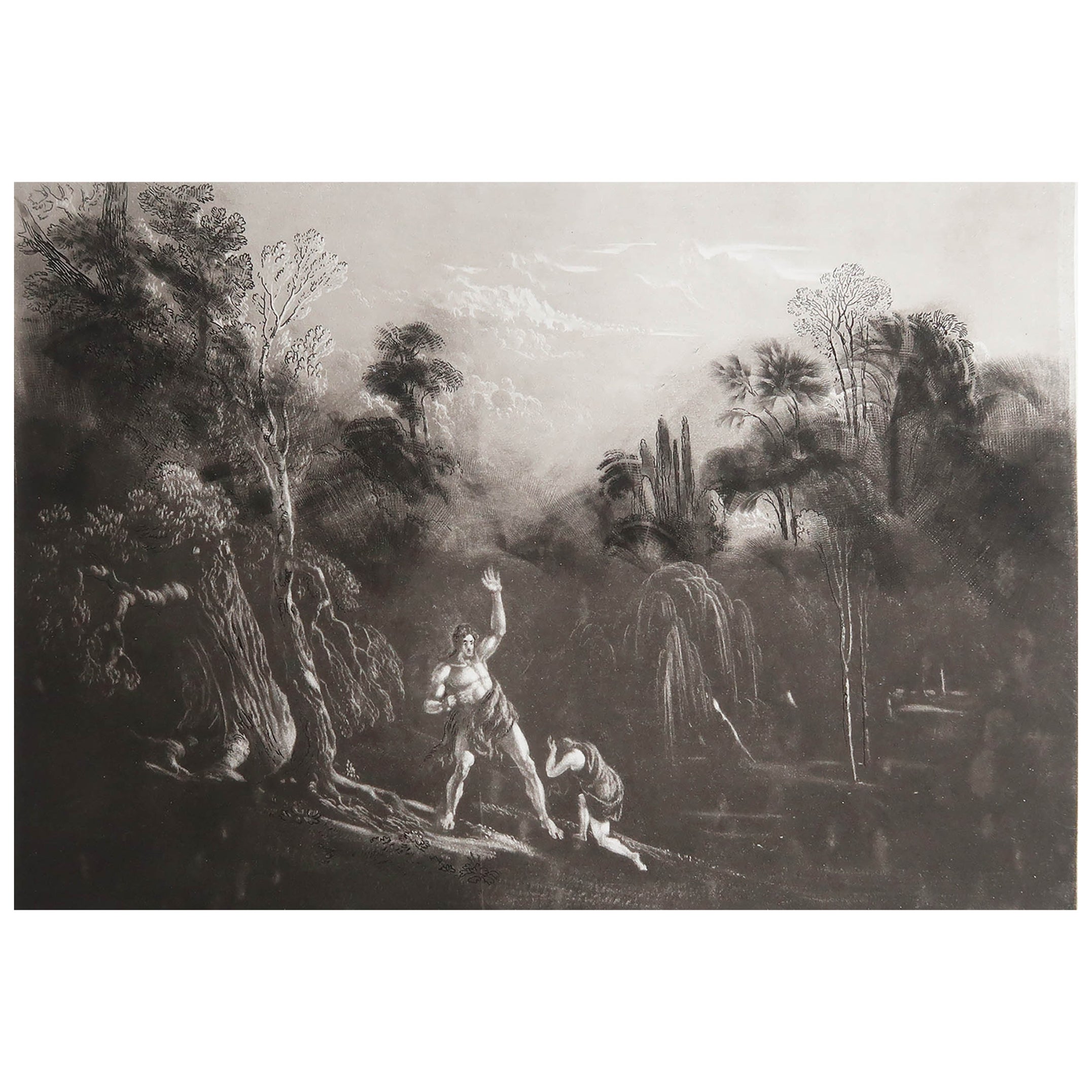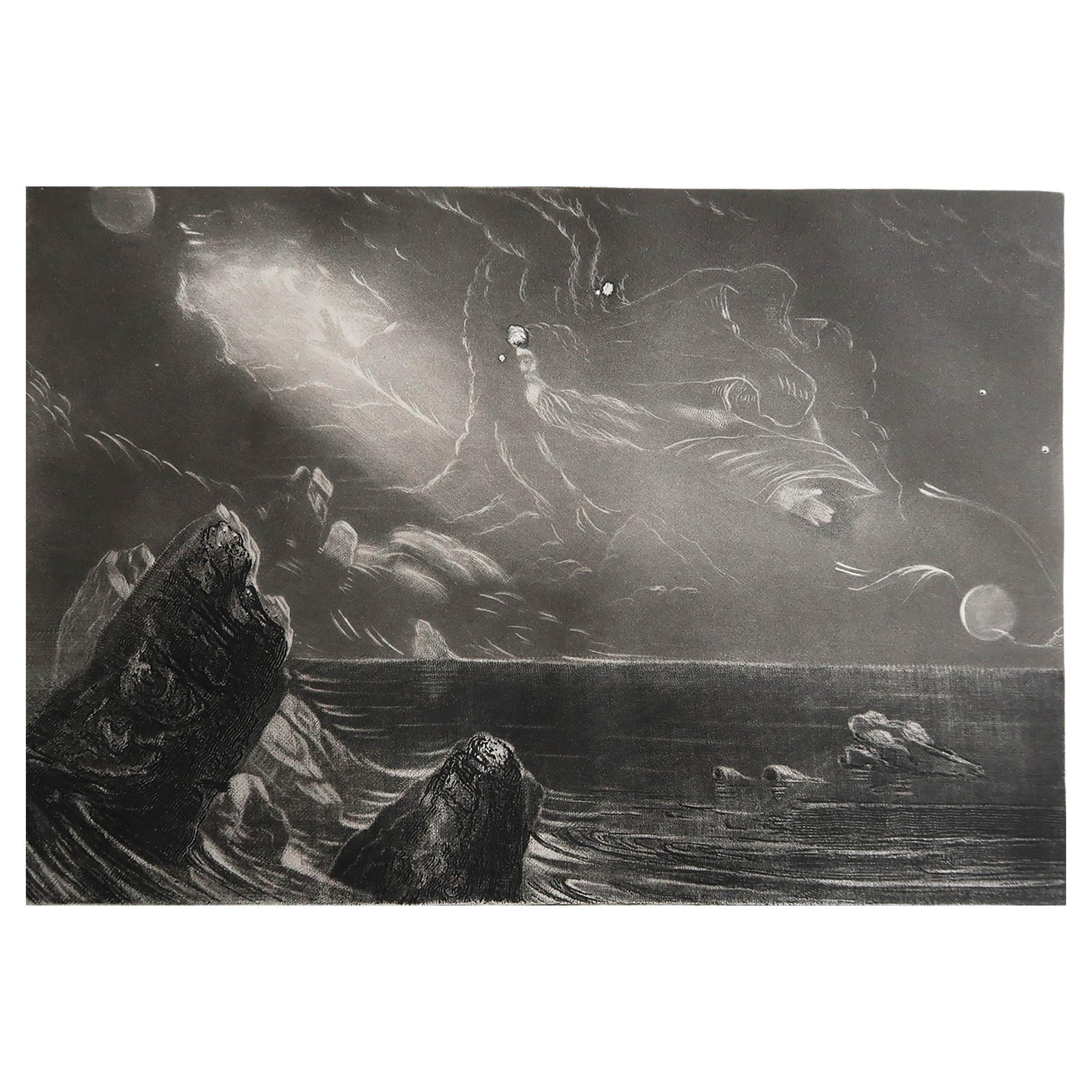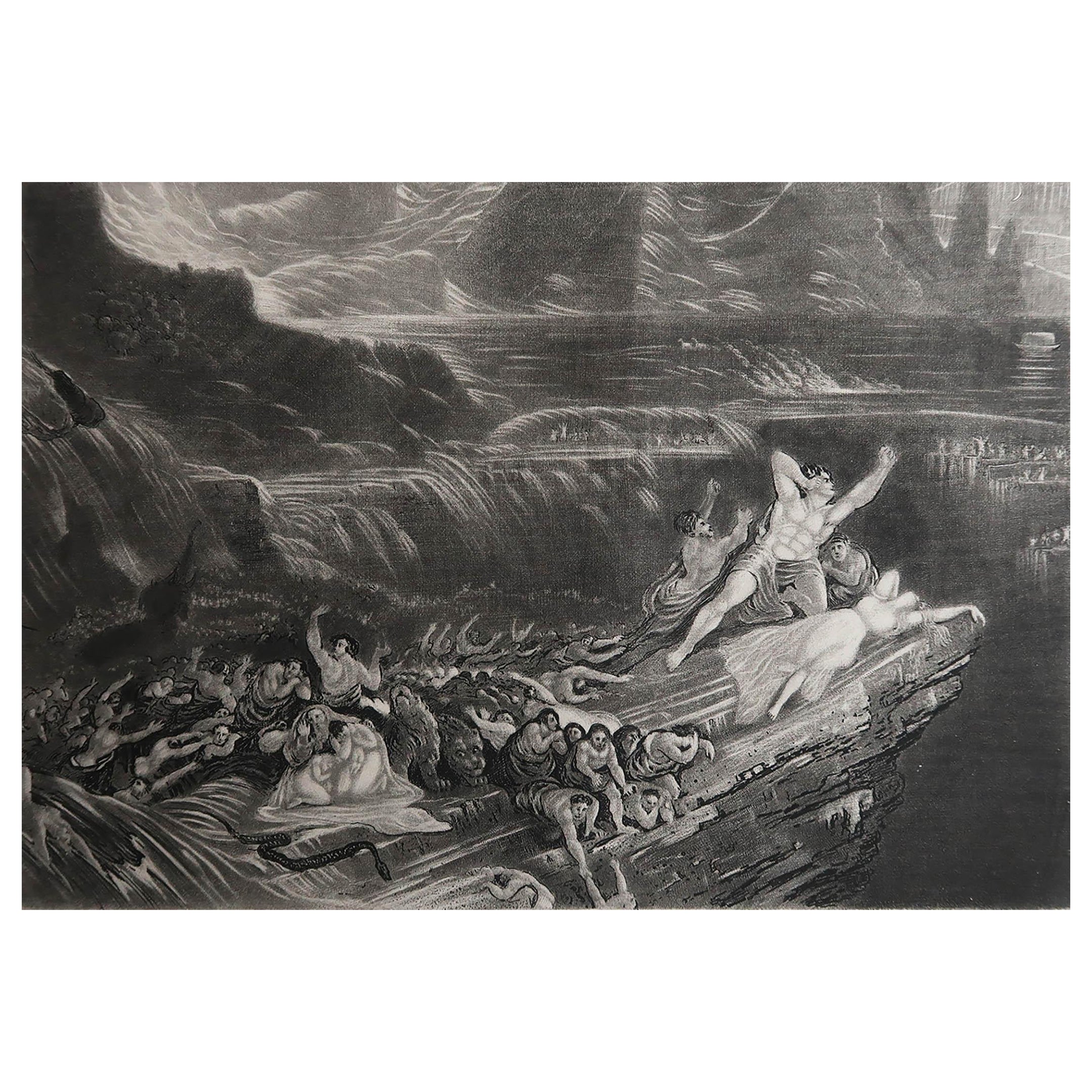Items Similar to George III Hand Coloured Reverse Mezzotint on Glass, P. Stampa, London, 1799
Want more images or videos?
Request additional images or videos from the seller
1 of 10
George III Hand Coloured Reverse Mezzotint on Glass, P. Stampa, London, 1799
About the Item
A wonderful George III, hand coloured reverse mezzotint on glass, produced by P. Stampa, in London in 1799. The piece is titled 'An Emblem of England', and is one of a series of four emblems of the United Kingdom, the other three being Wales, Ireland and Scotland. Each one included an allegorical figure and various emblems.
P. Stampa was a print seller and publisher of mezzotints, active in London in the second half of the 18th Century.
A very evocative piece with wonderful colours and depth.
- Dimensions:Height: 16 in (40.64 cm)Width: 12 in (30.48 cm)Depth: 0.75 in (1.91 cm)
- Style:Romantic (In the Style Of)
- Materials and Techniques:
- Place of Origin:
- Period:1790-1799
- Date of Manufacture:1799
- Condition:Wear consistent with age and use.
- Seller Location:Toronto, CA
- Reference Number:1stDibs: LU8854235592982
About the Seller
5.0
Gold Seller
These expertly vetted sellers are highly rated and consistently exceed customer expectations.
Established in 2022
1stDibs seller since 2023
29 sales on 1stDibs
Typical response time: <1 hour
- ShippingRetrieving quote...Ships From: Toronto, Canada
- Return PolicyA return for this item may be initiated within 14 days of delivery.
Auctions on 1stDibs
Our timed auctions are an opportunity to bid on extraordinary design. We do not charge a Buyer's Premium and shipping is facilitated by 1stDibs and/or the seller. Plus, all auction purchases are covered by our comprehensive Buyer Protection. Learn More
More From This SellerView All
- Three Etchings of Gentlewomen by Wensceslaus Hollar, 1607-1677Located in Toronto, CAA wonderful trio of etchings of gentlewomen by Wenceslau Hollar, who was born in Prague in 1607 and died in London in 1677. The largest, A Woman of Holland, is inscribed on the upper...Category
Antique 17th Century English Baroque Prints
MaterialsPaper
- Set of Twelve 18th century Printer's DevicesLocated in Toronto, CASet of twelve individual sheets with affixed printers' devices, each featuring individual designs along with wording in old french, dating from approximately 1700. Printers' devices ...Category
Antique Early 1700s French Louis XV Prints
MaterialsPaper
- Giovanni Benedetto Castiglione, 1609-1664, Young Man, Etching Circa 1640By Giovanni Benedetto CastiglioneLocated in Toronto, CAThis is an original etching by Giovanni Benedetto Castiglione, circa 1640, of a Young Man Looking Down to the Right. It is the only known state and belongs to the series known as 'Studies of Heads in Oriental Headdress'. Signed (in monogram) in the plate in the upper right 'G Castiglione Genovese.' In a delicate gilt/black frame. Frame dimensions 12.75" by 8.75". Certificate of Authenticity. In this work, Castiglione offers us an exquisite portrait of a young man. This small etching shows all the hallmarks of Castiglione's style: incredibly detailed etching marks that result in a wonderful play of light and shadow. The angle of the head and the lively floating feather in the young man's hat show us a figure in movement, pausing to look at something the viewer can only guess at. That such a small collection lines and cross-hatchings can evoke so much is a testament to Castiglione's genius. Giovanni Benedetto Castiglione was an Italian Baroque painter, printmaker and draftsman of the Genoese school. He is best known now for his etchings, and as the inventor of the printmaking technique of monotyping. He was known as Il Grechetto in Italy and in France as Le Benédette. Castiglione was a brilliant draftsman and pioneered the development of the oil sketch (often using a mixture of mediums) as a finished work. He is credited with having invented the monotype in 1648, the only printmaking technique to be an Italian invention, making over twenty over the succeeding years. His most popular and influential prints were a series of exotic heads, mostly of vaguely Oriental males, but also of women. From Bartch/Bellini: Giovanni Benedetto Castiglione was profoundly influenced by foreigners. He first studied with local artists in his native Genoa, absorbing not only Tuscan Mannerism and Caravaggism but also the style of Peter Paul Rubens, who had worked in Genoa. From 1621, Castiglione also worked in Anthony van Dyck's Genoa studio. Early on, he was attracted to Flemish animal painting. Though he painted portraits, historical pieces and landscapes, Castiglione excelled in rural scenes with animals and influenced Italy's animal painting specialists. By 1634, Castiglione was in Rome, where he remained for about ten years. After returning to Genoa for a time, he worked for the Mantuan court in 1648, which had also employed Rubens. There Castiglione picked up the freedom of touch he saw in Domenico Fetti's paintings. One of the first Italians to appreciate Rembrandt van...Category
Antique 17th Century Italian Baroque Prints
MaterialsPaper
- Four Continental Engraved Gilt Green Glass Roemers, Glasses, c.1900Located in Toronto, CAAn exquisite set of four Roemer glasses, circa 1900. Each in bright green glass engraved and gilded with scrolling flowers and graduated gold rims. All four in mint condition. These ...Category
Early 20th Century Dutch Romantic Glass
MaterialsGlass
- Mother and Child, Hugh Cameron, Scottish, 1835-1918, Oil on CanvasLocated in Toronto, CAA beautiful oil on canvas by Scottish 19th century artist Hugh Cameron, RSA RSW, ROI (1835-1918), in an exquisite gilt frame. This painting is a particularly moving and wistful examp...Category
Antique Late 19th Century Scottish Romantic Paintings
MaterialsCanvas
- Antique Balinese Hand-Carved PanelLocated in Toronto, CABeautiful antique Balinese door, probably 19th century. This door/shutter has been deeply and intricately hand-carved with scrolls, flowers and t...Category
Antique 19th Century Balinese Other Sculptures and Carvings
MaterialsWood
You May Also Like
- 18th Century George III Set of Six Mezzotints Depicting LucretiaBy John Raphael SmithLocated in Dublin 8, IE18th century George III set of six mezzotints depicting Lucretia, circa 1780, ‘Domestic Happiness’, ‘The Elopement’, ‘The Virtuous Parent’, ‘Dressing for Masquerade’, ‘The Tavern Door’, ‘The Fair Penitent’. Engraved by John Raphael Smith, (1751 – 1812) and painted by George Morland, (1763 – 1804). Engraved by John Raphael Smith, (1751 – 1812) was a British painter and mezzotinter, son of Thomas Smith of Derby, the landscape painter, and father of John Rubens Smith, a painter who emigrated to the United States. Smith became a London publisher from 1781, including among his clients the radical writer and artist William Blake. A prolific mentor of apprentices, he shared plates with at least thirty other London printers. In this group was J. M. W. Turner, Charles H. Hodges, William Ward, Thomas Girtin...Category
Antique Late 18th Century English Georgian Prints
MaterialsPaper
- Stampa su laminatoLocated in Torino, PiemonteBellissima stampa plastificata montata su laminato leggero. Questo quadro dai colori accattivanti e raffinati è ideale per arredare una parete moderna. Autore sconosciuto.Category
21st Century and Contemporary European Prints
MaterialsLaminate
- Hand-finished Mezzotint Engraving of Amaranthus TricolorLocated in Langweer, NLAntique print titled 'Amaranthus tricolor (..)'. Hand-finished mezzotint engraving of amaranthus tricolor, known as edible amaranth. This print originates from 'Phytanthoza Iconograp...Category
Antique Mid-18th Century Prints
MaterialsPaper
- 18 Antique Bird Hand-Coloured EngravingsLocated in New York, NYAntique Bird Prints Natural History Studies of Parrots and Tropical Birds Hand-colored engravings 23.5 x 30.5 inches each including frame Imagine all 18 on one wall in your study.Category
Antique 19th Century European Prints
MaterialsPaper
- Hand-finished Mezzotint Engraving of three Cotyledon speciesLocated in Langweer, NLAntique print titled 'Cotyledon Africanum (..)'. Hand-finished mezzotint engraving of three cotyledon species. This print originates from 'Phytanthoza Iconographia' by Johann Wilhelm...Category
Antique Mid-18th Century Prints
MaterialsPaper
- Hand-finished Mezzotint Engraving of two Chrysanthemum speciesLocated in Langweer, NLAntique print titled 'Chrysanthemum bidens (..)'. Hand-finished mezzotint engraving of two chrysanthemum species. This print originates from 'Phytanthoza Iconographia' by Johann Wilh...Category
Antique Mid-18th Century Prints
MaterialsPaper
Recently Viewed
View AllMore Ways To Browse
Irish Figural
Glass 18th Century Etched
Reverse Glass Mezzotint
Large Oak Display Cabinet
18th Century French Corner Cabinet
19th Century Antique Tall Storage Cabinet
3 Door With Mirror
Antique Clock Door Glass
Antique Coromandel
Antique Drop Leaf Table With Drawer
Antique French Clock With Garnitures
Antique French Fire Back
Antique Hand Painted Chinese Screen
Antique Painted Wardrobe
Antique Wall Screens
Antique Wardrobe Painted
Asian Charger
Black More Venetian
